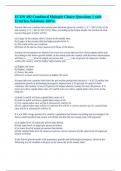Exam (elaborations)
ECON 402 Combined Multiple Choice Questions || with Errorless Solutions 100%.
- Course
- Institution
Assume that two countries have production functions given by country 1: Y = AK^(1/3)L^(2/3) and country 2: Y = AK^(1/2)L^(1/2). Then, according to the Solow model, the fraction of total income that goes to labor will be: (a) Larger in the country that is closest to the steady state. (b) Larger ...
[Show more]



